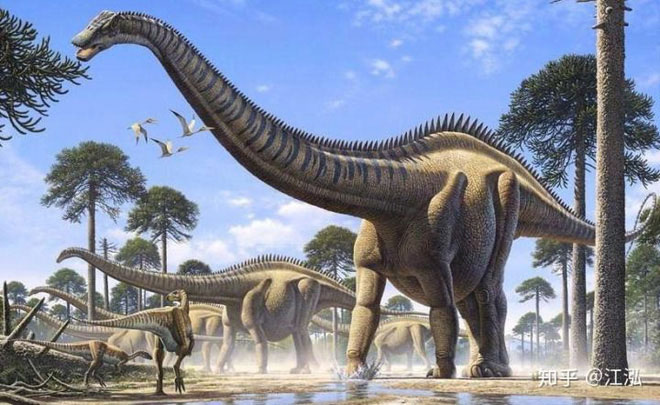The oldest hairy dinosaur found in North America, lived 150 million years ago
North America is considered to be a prehistoric dinosaur park, archaeologists have discovered it is home to the majority of large dinosaurs such as Brontosaurus, Stegosaurus, Torvosaurus . And it seems that in this area very rare dinosaurs of small size.
Recently, paleontologists have discovered the exact opposite, recently a small carnivorous dinosaur that we have never known before, more special in humans. They are covered with fur.
The discovery of the new dinosaur originated from the fossils of a giant Supersaurus in 2001 in Douglass in Montgomery County, Pennsylvania, USA, by archaeologists from the Tate Museum, Brother. At the nearby Jimbo quarry, the expedition found a super dinosaur fossil. After preliminary analysis and measurement, this fossil reached a length of 34 m.

Tate Museum, England.

Supersaurus (meaning "super dinosaur") is a subspecies of the sauropoda and diplodocidae, discovered by Vivian Jones in Delta, Colorado, living in the early Jurassic (Morrison Formation, about 153 million years ago). Supersaurus is one of the largest sauropoda, which can reach a length of 33-34m, a height of 5-5.2m, and a weight of 35-45 tons.
In order to better understand and analyze the fossil of this super dinosaur, paleontologists began to excavate and separate them from the rock, but the surprise is hidden behind it. , they did not know that after the discarded layers of rock and soil were fossils of another small dinosaur, so the excavation accidentally dropped that fossil.
Only in 2003 did paleontologists identify the fossil of this small carnivorous dinosaur from the discarded rocks. This tiny fossil was called "Lori" , and the nickname came from volunteer Lori Hockemeyer - who was involved in the excavation work.

Fossils of "Lori".
Fossil samples of "Lori" are WYDICE-DML-001 including: part of skull, lower jaw bone, five neck vertebrae, first back vertebrae, tail bone, rib, foot bone, clavicle right, left femur and part of his right leg.
All the bones are still connected, through paleontological analysis revealed that this is the fossil of an adult.
Initially, it was thought that the fossil of this small dinosaur was nothing special, but in 2008, when paleontologist Lomax first encountered this fossil, he felt it had Something more special than what people think.
In 2015, Lomax was finally able to send fossils of "Lori" to the University of Wisconsin-Madison for comprehensive research.
On July 10, 2019, a paleontologist published a study in the journal PeerJ, entitled "The all-new Paraves dinosaurs from the late Jurassic period in North America was able to fly".
Therefore "Lori" is scientifically named "Hesperornithoides", derived from the Greek "Ἑσπερίς" (meaning "western"), "ὄρὄρςς" (meaning "bird") and "eides" in Latin (meaning "morphological"), Meaning "Western dinosaur with the shape of a bird".
Hesperornithoides is a carnivorous dinosaur with a fairly small body with a body length of only 1 m and weighs about 2kg, but in return, they have speed and flexibility.

These dinosaurs have unusually large eyes.
Although their skulls are very small, these dinosaurs have unusually large eyes, which proves that it has very good vision and may be a nocturnal species, followed by small teeth. pointed and curved - typical characteristics of predators.

They have developed limbs, its front legs have three toes and sharp claws at each tip.
Hesperornithoides has a long neck and a fairly solid body, followed by a long slender tail on the back. They have developed limbs, its front legs have three toes and sharp claws at each tip.
Compared to the front legs, their hind legs are very long and strong, which shows that they are a dinosaur capable of running at high speeds. There is a very unique position on their hind feet, the second toe is raised and the claws at that toe are bigger and sharper than the nails on the other toes.
This is also considered a distinguishing feature of this species, that strange claw that functions as a hunting weapon and is often used to kill prey.
In addition, the fossil record of this species also retained the trace of feathers, through analysis of paleontologists discovered that they lived from the Jurassic period 150 million years ago and are considered dinosaurs. The oldest fur found in North America.
Paleontologists believe that the Hesperornithoides often live in the forest near the water's edge. They are agile and intelligent small hunters, their prey is mainly lizards, small mammals and other small dinosaurs.
- Discovered super long neck dinosaurs
- The earth suddenly changes, giving birth to a series of "monsters" super terrible
- The oldest horned dinosaur in North America
- Tyrannosaurus T-rex and Giganotosaurus, which one will win?
- Found the dinosaur skull dating to 65 million years in the United States
- Find the oldest relative of T.rex
- Found the oldest fossil monkey in America in Panama
- The discovery of monkey fossils in North America 21 million years ago
- Discover new giant dinosaurs
- 9-year-old boy found fossil dinosaur eggs 66 million years
- Discover the oldest dinosaur protein
- Discover the oldest DNA man in North America
- Biological fossil discovery 545 million years ago
- The dinosaur tails remain intact in the amber mass of 99 million years
 Discovered an ancient centipede fossil 99 million years old
Discovered an ancient centipede fossil 99 million years old Discovered bat-like dinosaurs in China
Discovered bat-like dinosaurs in China Discovered a 200-year-old bronze cannon of the coast
Discovered a 200-year-old bronze cannon of the coast Discover 305 million-year-old spider fossils
Discover 305 million-year-old spider fossils